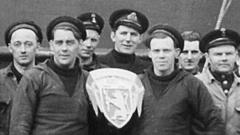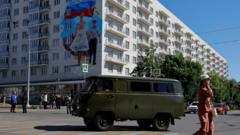As part of VE Day commemorations, six historic vessels retrace the perilous journeys of the Shetland Bus, highlighting its role in rescuing allies and fostering hope during WWII.**
The Unsung Heroes of the Shetland Bus: An Operation of Courage and Hope**

The Unsung Heroes of the Shetland Bus: An Operation of Courage and Hope**
Celebrating the legacy of the Shetland Bus operation, a clandestine effort aiding Norway's resistance against Nazi occupation.**
In the harsh winters of World War II, an extraordinary and covert operation known as the 'Shetland Bus' emerged, defying the Nazi occupation in Norway. This daring initiative involved small fishing boats setting out from the rugged coasts of Scotland to deliver crucial supplies, agents, and hope to the Norwegian resistance, covering around 200 miles across treacherous waters.
This year marks the 80th anniversary of Victory in Europe (VE) Day, and to honor the brave spirit of those involved, six vintage vessels from the Shetland Bus fleet are once again leaving Bergen, Norway, returning to Shetland. The ships are expected to arrive just in time for VE Day events, a poignant reminder of their historical mission.
The Shetland Bus operation commenced following Norway's invasion by German forces on April 8, 1940. As the Norwegian government and royal family fled to London, many citizens also sought refuge in the UK, risking their lives aboard fishing boats. In response to this urgent need for aid, British Prime Minister Winston Churchill authorized the creation of the Special Operations Executive (SOE), commissioning the Shetland Bus to conduct vital espionage operations.
Over the years from 1940 to 1945, approximately 200 dangerous North Sea crossings took place, with crews transporting resistance fighters, arms, and food supplies, while also rescuing over 300 refugees. The strong sense of camaraderie and mutual support shown by the Viking spirit was essential to maintaining the uplifted morale of Norwegians under fascist rule.
One maritime journey encapsulating their perilous missions was on the M/K Arnefjord, which, despite facing violent storms, managed to deliver 20 refugees to safety. While some voyages resulted in successful landings, others tragically ended in loss, with 10 boats sinking and 44 crew members paying the ultimate price.
Today, as Morten Neset, a skipper aboard the M/K Arnefjord, reflects on these profound journeys, he emphasizes their importance to the Norwegian populace. He states, "Everyone felt someone was 'standing up for them'." The recurring phrase "taking the Shetland Bus" served as both a metaphor for hope and a dangerous yet vital route to sanctuary.
As the returning Liberation Convoy prepares for its celebratory journey back to Lerwick on May 6th, the stories of resilience, sacrifice, and the partnerships forged between Scotland and Norway during this dark time in history are celebrated. A memorial in Scalloway humbly honors those who lost their lives while striving for freedom against tyranny.
This year marks the 80th anniversary of Victory in Europe (VE) Day, and to honor the brave spirit of those involved, six vintage vessels from the Shetland Bus fleet are once again leaving Bergen, Norway, returning to Shetland. The ships are expected to arrive just in time for VE Day events, a poignant reminder of their historical mission.
The Shetland Bus operation commenced following Norway's invasion by German forces on April 8, 1940. As the Norwegian government and royal family fled to London, many citizens also sought refuge in the UK, risking their lives aboard fishing boats. In response to this urgent need for aid, British Prime Minister Winston Churchill authorized the creation of the Special Operations Executive (SOE), commissioning the Shetland Bus to conduct vital espionage operations.
Over the years from 1940 to 1945, approximately 200 dangerous North Sea crossings took place, with crews transporting resistance fighters, arms, and food supplies, while also rescuing over 300 refugees. The strong sense of camaraderie and mutual support shown by the Viking spirit was essential to maintaining the uplifted morale of Norwegians under fascist rule.
One maritime journey encapsulating their perilous missions was on the M/K Arnefjord, which, despite facing violent storms, managed to deliver 20 refugees to safety. While some voyages resulted in successful landings, others tragically ended in loss, with 10 boats sinking and 44 crew members paying the ultimate price.
Today, as Morten Neset, a skipper aboard the M/K Arnefjord, reflects on these profound journeys, he emphasizes their importance to the Norwegian populace. He states, "Everyone felt someone was 'standing up for them'." The recurring phrase "taking the Shetland Bus" served as both a metaphor for hope and a dangerous yet vital route to sanctuary.
As the returning Liberation Convoy prepares for its celebratory journey back to Lerwick on May 6th, the stories of resilience, sacrifice, and the partnerships forged between Scotland and Norway during this dark time in history are celebrated. A memorial in Scalloway humbly honors those who lost their lives while striving for freedom against tyranny.


















